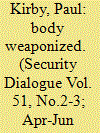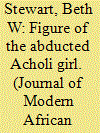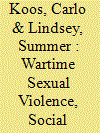|
|
|
Sort Order |
|
|
|
Items / Page
|
|
|
|
|
|
|
| Srl | Item |
| 1 |
ID:
175123


|
|
|
|
|
| Summary/Abstract |
It is today common to argue that rape is a weapon, tool or instrument of warfare. One implication is that armed groups marshal body parts for tactical and strategic ends. In this article, I interrogate this discourse of embodied mobilization to explore how body weaponry has been made intelligible as a medium for sexual violence. First, I show that, despite wide rejection of essentialist models, the penis and penis substitutes continue to occupy a constitutive role in discussions of sexual violence in both political and academic fora, where they are often said to be like weapons, a tendency I term ‘weapon talk’. Second, I trace the image of the body weapon in key threads of feminist theorizing and commentary, to show how the penis has appeared as a ‘basic weapon of force’ in various permutations. Third, I explore the weaponization of the body as it appears in military thought and in the cultural circulation of ideas about the soldiering body in which sexual pleasure and violence are frequently conflated. Building on this foundation, I propose that these literatures collectively describe an uncanny weapon object, and I draw out the significance of this term for feminist security studies and martial empiricism. In short, the uncanny haunts accounts of sexual violence in the collision of sexuality and machinery in the image of a body weapon, in the unsettling designation of sexuality as itself both familiar and dangerous, and in the strange movement of violent bodies across the boundary between wartime and peacetime. A concluding discussion draws out implications and challenges for thinking about embodied violence, advocating renewed attention to the history of weaponization as a fallible and confounding process.
|
|
|
|
|
|
|
|
|
|
|
|
|
|
|
|
| 2 |
ID:
178008


|
|
|
|
|
| Summary/Abstract |
Based on analysis of newspapers and secondary sources, this article examines the gendered construction of the national imagery of the war between the Ugandan government and the Lord's Resistance Army (LRA) in an effort to expand current conceptual understanding of the exclusion experienced by children born of forced marriage inside the LRA. Uganda developed as a militarised and masculine post-colony and yet nation-building for President Museveni involved crafting a national imagery that drew upon development discourses of gender and children to position himself as the benevolent father of the nation. Invoking Veena Das’ ‘figure of the abducted woman’, I argue that the Ugandan government mobilised the figure of the abducted Acholi girl to legitimise both its governance and the war. The article concludes that the resulting narrative provided no legitimate social or political space in the national imagery for the children of the abducted girls.
|
|
|
|
|
|
|
|
|
|
|
|
|
|
|
|
| 3 |
ID:
167379


|
|
|
|
|
| Summary/Abstract |
Recent years have seen an increased emphasis on both protection of civilians and the problem of sexual violence. We explore the impact of United Nations (UN) peacekeeping on the occurrence of wartime sexual violence. Acknowledging the difficulty in reducing sexual violence, we propose two conditions under which peacekeepers are more likely to be successful: when the mission has a protection mandate and when the conflict actors exercise a high level of control over their forces. We find that the ability of peacekeepers to reduce sexual violence in general is weak. Only police within protection missions reduces the risk of sexual violence by rebels. However, when the actors exercise control, the number of peacekeepers is associated with a lower risk of sexual violence by both governments and rebels. We conclude that dealing with sexual violence by weak and fragmented actors is a challenging task beyond the current capacity of UN peacekeeping.
|
|
|
|
|
|
|
|
|
|
|
|
|
|
|
|
| 4 |
ID:
089043


|
|
|
|
|
| Publication |
2009.
|
| Summary/Abstract |
This article is a comparative analysis of sexual violence perpetrated by state armed forces during the Guatemalan and Peruvian civil wars. Focusing on the type of violation and the context in which it occurs provides new insights into the motives behind its use in war. It introduces a new data set on sexual violence compiled from truth commission documents and nongovernmental human rights organizations' reports. The data reveal that members of the state armed forces perpetrated the majority of sexual violations, that rape and gang rape are the most frequent but not the only abuses committed, and that women are the overwhelming majority of victims of sexual violence. Aggregate patterns suggest that state authorities must have known of mass sexual abuse and failed to act in accordance with international law. Moreover, some evidence suggests sexual violence is used as a weapon of war. However, mono-causal models cannot sufficiently account for the variation and complexity in its use. Even within the same conflict, sexual violence can serve multiple functions in different contexts and at different points in time.
|
|
|
|
|
|
|
|
|
|
|
|
|
|
|
|
| 5 |
ID:
186336


|
|
|
|
|
| Summary/Abstract |
Sexual violence by armed groups is common in civil wars. Qualitative studies have shown that victims and their families experience social stigmatization. Stigmatization is viewed as a central mechanism to social exclusion and disintegration impeding post-conflict social, political, and economic recovery. We provide new theory on the social conditions under which rape-related stigma intensifies and decreases. Drawing on an original population-based survey in eastern Democratic Republic of Congo, we find that victims and their families experience higher levels of stigma compared to unaffected families and these effects are dependent on community attitudes and norms. Furthermore, we find that humanitarian support interventions designed to address the social nature of stigma can reduce stigma. Our article significantly expands prior knowledge on a central mechanism in post-conflict recovery by providing a refined theory on wartime rape-related stigma and the role of humanitarian aid in mitigating negative effects based on representative data.
|
|
|
|
|
|
|
|
|
|
|
|
|
|
|
|
|
|
|
|
|